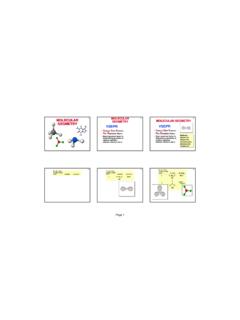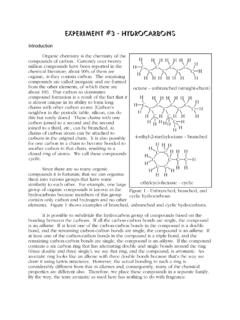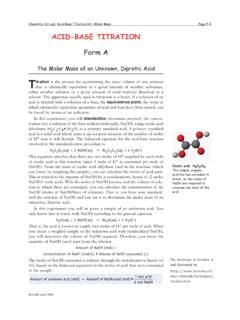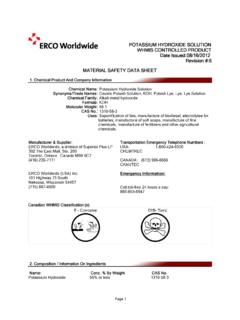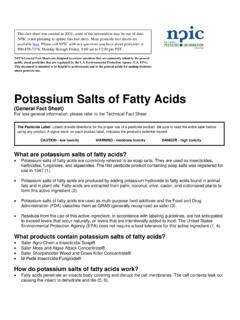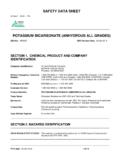Transcription of THE SYNTHESIS OF POTASSIUM ALUMINUM …
1 Chemistry 111 Laboratory: alum SYNTHESIS Page C-3. THE SYNTHESIS OF. POTASSIUM ALUMINUM . SULFATE ( alum ). FROM ALUMINUM SCRAP. The Chemical Recycling of Scrap ALUMINUM This experiment has the following objectives: 1. To be aware of the need for recycling solid wastes, particularly scrap metal like ALUMINUM . 2. To learn some of the chemistry of ALUMINUM . 3. To become familiar with the use of laboratory equipment such as beakers, flasks, Bunsen burners, and so on. 4. To be able to perform the techniques of weighing, gravity and vacuum fil- tration and crystallization. 5. To be able to apply a knowledge of the stoichiometry of a sequence of chemical reactions to the calculation of the percentage yield of alum syn- thesized from ALUMINUM scrap.
2 INTRODUCTION. Figure Two views of the unit Modern societies have concentrated on what might be considered the most cell (smallest, repeating unit). primitive of methods of solid waste disposal burning or burying! This type of ALUMINUM metal. See the of behavior is a strange anomaly, because solid waste is probably the oldest model of ALUMINUM on the of man's pollutants and yet has only recently received serious attention from Chem Lab page for the course. scientists and technologists. Like all other environmental problems, solid waste problems are intensified by modern civilization more people and more things. In 1920 the average Looking at solid waste American generated 2 3/4 pounds of solid waste per day; in 1970 the aver- from the disposal end age was 5 pounds per day and by 1980 it was about 8 pounds per day!
3 The gives one set of priorities. composition of all this solid waste is shown in the TABLE on the next page; Looking at solid waste from it is drawn from a Public Health Service study of municipal refuse for 1966- the standpoint of recycling yields a completely dif- 1968. ferent set of priorities Unfortunately, the problem is compounded by the fact that one of the and can illustrate areas most important types of resource at the base of our technological society is of technological need that metal. Metals such as copper, chromium, molybdenum, tin, zinc, tungsten, and previously have been over- looked. The salvage of alu- ALUMINUM have become as necessary to economics as water and fossil fuels.
4 Minum from mixed municipal ALUMINUM is a classic example! refuse is such an area.. ALUMINUM is the third most abundant element, and most abundant metal, From Recycling of Used in the Earth's crust. It is concentrated in a number of high-grade, natural ALUMINUM Products by Dr. Robert F. Testin. bauxite deposits, almost all of which are located outside of the Changes Revised: June 2005. Page C-4 Chemistry 111 Laboratory: alum SYNTHESIS SOLID WASTE PROFILE 1965 to 1968. Item % by Weight Paper products Glass Metals Vegetable scraps Meat scraps Other foods Leaves, grass, etc. Other Adjusted moisture in the international situation (the so-called Third World owns most of the bauxite), and the depletion of high grade ores, is forcing the ALUMINUM indus- try to use lower grade ores with correspondingly higher prices for ALUMINUM and products made from it.
5 At the same time this is happening, the use of ALUMINUM in disposable products ( , beverage cans, foil, etc.) is increasing enormously. Even the most solid of all solid wastes, the automobile, now con- tains more ALUMINUM alloys. The stimuli to recycle ALUMINUM are thus very strong and are being reinforced by other recent developments. The production of ALUMINUM from natural sources like bauxite ( ALUMINUM oxide, Al2O3) and cryolite (Na3 AlF6) involves an electrolytic process which uses large amounts of electricity. The sky-rocketing cost of that form of energy is well known! The energy costs of recycling ALUMINUM metal, by shredding, melting and casting, are a small fraction (about 5 10%) of the energy cost of producing the metal from ore.
6 Finally, in an ironic twist, one of the properties of ALUMINUM that is respon- sible for its current, wide-spread use can cause a serious environmental prob- lem. ALUMINUM does not corrode as does iron and steel. A fresh ALUMINUM surface reacts very rapidly with oxygen to produce an oxide coating that is so Figure An electrochemical cell used to produce ALUMINUM metal. The ALUMINUM , in the form of compounds such as Al2O3 in Na3 AlF6 is electro- lyzed (reduced) at a graphite cathode. Because the cell is at a high temperature, the alumi- num is molten, and is drawn off the bottom of the cell. See Chemistry & Chemical Reactivity, 6th edition, page 1035.
7 Revised: June 2005. Chemistry 111 Laboratory: alum SYNTHESIS Page C-5. tenacious and impervious that no further reaction takes place. The thin layer is not necessary. Hence, skyscraper facings, airplanes, Airstream trailers, and beer cans can be nice shiny objects. The discarded ALUMINUM can has become nearly immortal! It has an average lifetime" in the environment of greater than 100 years. There are now a number of successful recycling programs for ALUMINUM cans. Collection centers are paying around 15 cents per pound for scrap alu- minum. The problem of recycling cans that end up in the municipal landfill has not yet been solved, but progress is being made in designing large scale separators to separate ALUMINUM , steel, glass, and paper from trash.
8 The scrap For a photo of the recov- ALUMINUM is usually shredded, melted down, cast, and eventually made into ery of ALUMINUM metal from an ALUMINUM product. scrap see Figure (b). in Chemistry & Chemical In this experiment you will be recycling ALUMINUM scrap in a very unusual Reactivity, 6th edition, way, and you will produce two products which are potentially very useful: page 1035. hydrogen gas (H2) and very pure POTASSIUM ALUMINUM sulfate (KAl(SO4)2 12. H2O or alum ). Hydrogen gas has great potential use as a fuel, if some of its dangerous properties can be controlled (mixtures of H2 and air are highly explosive).
9 Hydrogen gas, when burned properly, produces a large amount of heat and no pollution, the only combustion product being water. alum is a widely used chemical in industry, playing an important role in the production alum is the hydrated com- pound KAl(SO4)2 12H2O. of many products used in the home and industry. The pulp and paper industry alone consumes 70% of the more than one million tons of alum produced annually in the It is used to size" the paper. The second largest use is in the purification of water for human and industrial consumption. Other uses include soaps, greases, fire extinguisher compounds, textiles, leather, synthetic rubber, drugs, cosmetics, cement, plastics, and pickles.
10 It is important to note here that this particular process for converting alu- minum into alum would produce very expensive alum ! alum can be made, very cheaply at the moment, using clay as the raw material. Consequently, the procedure used in this experiment is not used as an industrial method for recycling ALUMINUM . THE CHEMISTRY OF THE EXPERIMENT. ALUMINUM beverage cans generally have a thin coating of plastic on the inside that protects the ALUMINUM from the corrosive action of the chemicals in the beverage. The outside usually has a thin coating of paint. These coatings must be removed before any chemical reactions with the metal can be carried out.
